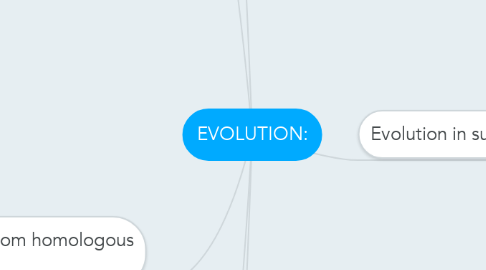EVOLUTION:
by Victoria Martens

1. Evolution in summary:
1.1. Evolution occurs when heritable characteristics of a species change
1.2. Strong evidence for characteristics of species change over time
1.3. It is at the heart of scientific understanding of the natural world
1.4. Important distinctions should be drawn between acquired characteristics that passed from parent to offspring
2. Evidence from fossils:
2.1. The fossil record provides evidence for evolution
2.2. Sequence in which fossils appear matches the sequence in which they would be expected to evolve
2.3. They could evolve with bacteria, simple algae, fungi, worms and land vertebrates
2.4. Sequence also fits in with ecology
2.5. More plant fossils appearing before animals
2.6. Sequences are known that link together in existing organisms
3. Evidence from selective breeding:
3.1. Selective breeding of domesticated animals shows that artificial selection can cause evolution
3.2. Large differences if modern breeds of livestock are compared with wild species that they resemble
3.3. Domesticated breeds do not always exist in their current form
3.4. Artificial selection is the only explanation that can be achieved simply by repeatedly selecting for and breeding individuals suited to human uses
3.5. The effectiveness is shown by considerable changes that occurred in domesticated animals over periods of time
3.6. Selection can cause evolution
4. Evidence from homologous structures:
4.1. Evolution of homologous structures by adaptive radiation explains similarities in structure when there are differences in function
4.2. Darwin noticed that The Origin of Species have some similarities in structure between organisms
4.3. Similarities between tail fins of whales and fish are known as analogous structures
4.4. Structures are very different
4.5. Evolutionary interpretation- they had different origins and become similar. They perform the same or similar function (Convergent Evolution)
4.6. Homologous structures are structures that look superficially different as well as perform different functions although they have "unity of type"
5. Speciation:
5.1. Populations of a species can gradually diverge into separate species by evolution
5.2. Two populations of species become separate so they do not interbreed and natural selection, they will evolve in different ways
5.3. Characteristics of a population will diverge over time
5.4. Speciation is when populations merge and have a chance at interbreeding but do not they would have evolved into separate species
6. Evidence from patterns of variation:
6.1. Continuous variation across the geographical range of related populations matches the concept of gradual divergence
6.2. Populations diverge over time so they can become separate species
6.3. Darwin pointed out that populations are recognizably different but are not separate species
6.4. Species diverge over long periods of time so there is no quick switch from a population to species to being separate species


